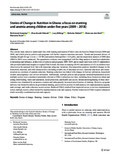| dc.contributor.author | Aryeetey, Richmond | |
| dc.contributor.author | Atuobi-Yeboah, Afua | |
| dc.contributor.author | Billings, Lucy | |
| dc.contributor.author | Nisbett, Nicholas | |
| dc.contributor.author | van den Bold, Mara | |
| dc.contributor.author | Toure, Mariama | |
| dc.coverage.spatial | Ghana | en |
| dc.date.accessioned | 2022-07-15T07:43:40Z | |
| dc.date.available | 2022-07-15T07:43:40Z | |
| dc.date.issued | 2021-11-28 | |
| dc.identifier.citation | Aryeetey, R.; Atuobi-Yeboah, A.; Billings, L.; Nisbett, N.; van den Bold, M. and Toure, M. (2021) 'Stories of Change in Nutrition in Ghana: a focus on stunting and anemia among children under-five years (2009 – 2018)', Food Security 14: 355–379, DOI: 10.1007/s12571-021-01232-1 | en |
| dc.identifier.uri | https://opendocs.ids.ac.uk/opendocs/handle/20.500.12413/17535 | |
| dc.description.abstract | The current study aimed to understand why child stunting and anemia (CS&A) rates declined in Ghana between 2009 and
2018, and which priority policies and programs will further improve nutrition outcomes. Trends and potential drivers of
stunting (height-for-age z-score<-2.0 SD) and anemia (hemoglobin<11.0 g/dL), and decomposition analysis of DHS data
(2003 to 2014) were conducted. The quantitative evidence was triangulated with Net-Map analysis of nutrition stakeholder
relationships and infuence, desk review of policies and programs 2009–2019, and in-depth interviews with 25 stakeholders
who provided additional insights to explain CS&A trends. Declines in stunting (29.6%) and anemia (14.1%) in children were
observed at the national level, but with important subgroup variations. Decomposition analyses identifed changes in the
household, maternal, and child characteristics (including wealth, use of antenatal services, maternal education, and immunization) as correlates of anemia reduction. Stunting reduction was linked with changes in bed-net utilization, household
wealth, and pregnancy care service utilization. Additionally, multiple policies and programs initiated/implemented across
multiple sectors were considered potentially relevant to CS&A reduction over time, including those focused on infant and
young child feeding, water and sanitation, social protection, and health care access. Initiation/strengthening of these interventions was stimulated by awareness creation and subsequently increased prioritization of stunting. However, program delivery was limited by defcits in government funding, perceived low priority of child anemia, low implementation capacity and coverage, and weak coherence across sectors. Reduced CS&A resulted from improved access to services implemented across multiple sectors, albeit limited by implementation scale and capacity. Further reduction in CS&A requires enhanced multi-sectorally coordinated actions and capacity. | en |
| dc.language.iso | en_US | en |
| dc.publisher | Springer Link | en |
| dc.relation.ispartofseries | Food Security;14 | |
| dc.rights.uri | http://creativecommons.org/licenses/by/4.0/ | en |
| dc.subject | Children and Youth | en |
| dc.subject | Health | en |
| dc.subject | Nutrition | en |
| dc.title | Stories of Change in Nutrition in Ghana: a focus on stunting and anemia among children under-five years (2009 – 2018) | en |
| dc.type | Article | en |
| dc.rights.holder | © The Author(s) 2021 | en |
| dc.identifier.externaluri | https://link.springer.com/article/10.1007/s12571-021-01232-1 | en |
| dc.identifier.team | Health and Nutrition | en |
| dc.identifier.doi | 10.1007/s12571-021-01232-1 | |
| dcterms.dateAccepted | 2021-11-17 | |
| rioxxterms.funder | Default funder | en |
| rioxxterms.identifier.project | Default project | en |
| rioxxterms.version | VoR | en |
| rioxxterms.versionofrecord | 10.1007/s12571-021-01232-1 | en |
| rioxxterms.funder.project | 9ce4e4dc-26e9-4d78-96e9-15e4dcac0642 | en |


